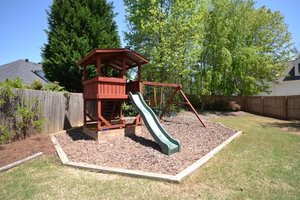Designing kid's play spaces
Backyard garden space is a wonderful gift to children. How better to introduce them to nature then in the safety of your own enclosed yard?
To begin with the obvious, you'll need boundary fencing and fencing to keep kids from any potential danger. Kids' natural curiosity can't be contained, so fence off tools, garden supplies, and places you don't want them to go.
Part of planning play spaces for children is a function of their age. As common sense would dictate, keep very young children close to the house so they can be easily watched and heard. Sandboxes (covered when not in use are a guaranteed hit, as is anything to do with water. But keep in mind that even shallow water can be a danger for little ones. Don't include a pond or pool until the kids are older and reliable around water. Similarly, as you choose plants, avoid those that are thorny, and certainly any that are poisonous.
Of all the opportunities you can provide for you children in the garden, perhaps the greatest is a space of their own. Screen it if you can, for at least the illusion of privacy, and so that their messes aren't an issue when company comes around. But for as long as supervision is critical, make the space easy to see from the house or an upper-story window.
Take sun, wind, and shade into account. Hot sun increases the risk of sunburn and can make metal slides or bars, as well as concrete walks, burning hot, so install slide surfaces facing north. If your property is in the path of strong winds, locate the play yard inside a windbreak of fencing or dense trees. Dappled shade is ideal. If you have no spreading foliage, position the play yard on the north side of your house, construct a simple canopy of lath or canvas, or play structure that includes a shaded portion.

